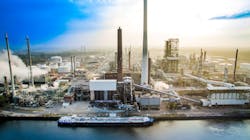BP plans renewable hydrogen production at German refinery
BP PLC and Ørsted AS of Denmark and have agreed to jointly develop a proposed large-scale renewable hydrogen project at subsidiary BP Europa SE’s 100,000-b/d Lingen refinery in northwest Germany’s Emsland region.
Scheduled to become operational in 2024, the Lingen Green Hydrogen (LGH) project will include a 50-Mw electrolyzer and associated infrastructure capable of generating 1 tonne/hr—or nearly 9,000 tonnes/year—of renewable hydrogen sufficient to replace about 20% of the refinery’s current fossil-based hydrogen consumption, BP and Ørsted said.
The LGH project—which would reduce carbon dioxide (CO2) equivalent emissions by about 80,000 tpy in its initial phase—also intends to support the partners’ longer-term ambition to build more than 500 Mw of renewable hydrogen capacity at Lingen to meet the refinery’s entire hydrogen demand, as well as provide feedstock for future synthetic fuel production at the site.
Designed to replace the Lingen refinery’s current CO2 emissions-generating method of producing hydrogen via natural gas reforming, the proposed LGH project’s electrolysis-based system—which will be powered by an Ørsted North Sea offshore wind farm—would split water into hydrogen and oxygen gases to produce zero-emissions green hydrogen.
Alongside green hydrogen production, the project also will focus on maximizing electrolyzer-system efficiency to enable flexible operation and complete integration into the refinery. To accommodate the latter objectives, scope of the engineering and commercial studies will include assessments for sustainable uses of the main by-products of electrolysis, primarily oxygen and low-grade excess heat, Ørsted said.
Already having jointly applied to fund the LGH project with the EU Innovation Fund—currently one of the largest funding programs for innovative low-carbon technologies that focuses particularly on energy intensive industries—BP and Ørsted will now work together to further define the project and agree on definitive documents for a targeted a final investment decision (FID) in early 2022.
“Heavy industries such as refineries use large quantities of hydrogen in their manufacturing processes. They will continue to need hydrogen, but replacing the currently fossil-based hydrogen with hydrogen produced from renewable energy can help these industries dramatically lower their CO2 footprint,” said Martin Neubert, Ørsted’s executive vice-president.
“But first, renewable hydrogen has to become cost competitive with fossil-based hydrogen, and for that we need projects such as [the LGH project to] demonstrate the electrolyser technology at large scale and showcase real-life application of hydrogen based on offshore wind,” Neubert added.
For BP, the project comes as part of its strategy to develop its hydrogen business in line with the operator’s goal of becoming a net-zero company by 2050 or sooner.
“Hydrogen will have an increasing role to play in meeting the energy demands of a decarbonizing world. And we are determined to build a leading position in this emerging industry,” said Dev Sanyal, executive vice-president for BP’s gas and low-carbon business.
In addition to accelerating a major reduction in the Lingen refinery’s emissions and building BP’s experience in large-scale green hydrogen production and deployment, the LGH project has the potential to play an important role in the development of a hydrogen economy, in Germany and beyond, according to Sanyal.
About the Author
Robert Brelsford
Downstream Editor
Robert Brelsford joined Oil & Gas Journal in October 2013 as downstream technology editor after 8 years as a crude oil price and news reporter on spot crude transactions at the US Gulf Coast, West Coast, Canadian, and Latin American markets. He holds a BA (2000) in English from Rice University and an MS (2003) in education and social policy from Northwestern University.

